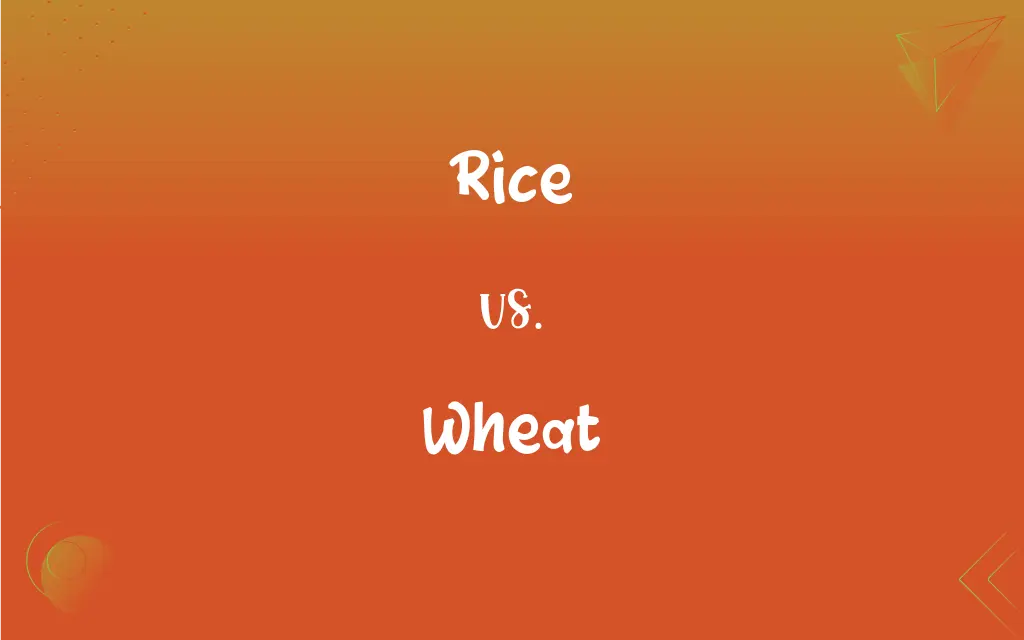Rice vs. Wheat: What's the Difference?
Edited by Aimie Carlson || By Janet White || Published on January 24, 2024
Rice is a cereal grain, typically grown in paddies, and a staple in many Asian diets, while wheat is a staple cereal grain used globally, often in bread and pastries.

Key Differences
Rice is a cereal grain that belongs to the species Oryza sativa (Asian rice) or Oryza glaberrima (African rice). Wheat is also a cereal grain, classified under the genus Triticum. Rice and wheat differ significantly in their species classification and genetic makeup, contributing to their distinct agricultural and culinary properties.
The cultivation of rice typically requires a lot of water and is often grown in flooded fields called paddies. In contrast, wheat can be grown in a wider range of climatic conditions, often in drier and cooler environments than rice. These differences in cultivation requirements impact their geographical distribution and farming practices.
In terms of nutrition, rice is generally a good source of carbohydrates and energy but lower in protein than wheat. Wheat, on the other hand, is rich in protein, fiber, and various vitamins and minerals. The nutritional profiles of rice and wheat make them suitable for different dietary needs and culinary uses.
Rice grains are typically consumed whole, either white or brown, and are a staple food in many Asian countries. Wheat is often processed into flour and used for making bread, pasta, and pastries, forming a dietary staple in many parts of the world. The processing and consumption methods of rice and wheat vary widely, reflecting their cultural and culinary significance.
Rice has varieties like basmati, jasmine, and sushi rice, each with unique characteristics suitable for different dishes. Wheat varieties include durum, used in pasta, and hard red wheat, used in bread-making. These varieties cater to specific culinary requirements and preferences, showcasing the versatility of both grains.
ADVERTISEMENT
Comparison Chart
Botanical Classification
Oryza species
Triticum species
Cultivation Requirements
Requires flooded conditions (paddies)
Grows in drier, cooler environments
Nutritional Content
High in carbohydrates, lower in protein
High in protein, fiber, and vitamins
Common Forms of Consumption
Consumed whole (white or brown rice)
Often processed into flour for bread and pastries
Varieties and Uses
Basmati, jasmine, sushi rice for different cuisines
Durum for pasta, hard red for bread-making
ADVERTISEMENT
Rice and Wheat Definitions
Rice
Rice is typically grown in water-intensive paddies in many Asian countries.
The rice paddies in Vietnam are known for their picturesque landscapes.
Wheat
Wheat varieties include durum, used in pasta, and hard red, used in bread-making.
Durum wheat is specifically cultivated for making high-quality pasta.
Rice
Rice is essential in global food security, feeding billions worldwide.
In many countries, rice is a primary component of the daily diet.
Wheat
Wheat is cultivated in diverse climates, from temperate regions to arid zones.
The wheat fields of Kansas contribute significantly to global wheat production.
Rice
Rice can be classified into white rice, brown rice, and specialty types like basmati.
Brown rice is preferred for its higher nutritional value compared to white rice.
Wheat
Wheat is a major dietary staple in many cultures, particularly in Europe and North America.
In Western diets, wheat-based products like bread and pasta are ubiquitous.
Rice
Rice is a versatile grain used in dishes ranging from sushi to risotto.
Sushi requires a specific type of short-grain rice for the perfect texture.
Wheat
Wheat is a cereal grain that is a primary source of flour for bread, pasta, and pastries.
Wheat flour is the main ingredient in most types of bread.
Rice
Rice is a cereal grain cultivated worldwide and a staple in many diets.
Rice is often served as a side dish in various Asian cuisines.
Wheat
Wheat provides essential nutrients like protein, fiber, and B vitamins.
Whole wheat is recommended for its health benefits over refined wheat.
Rice
A cereal grass (Oryza sativa) that is cultivated extensively in warm climates for its edible gn.
Wheat
Any of various annual cereal grasses of the genus Triticum of the Mediterranean region and southwest Asia, especially T. aestivum, widely cultivated in temperate regions in many varieties for its commercially important edible grain.
Rice
The starchy gn of this plant, used as a staple food throughout the world.
Wheat
The grain of any of these grasses, ground to produce flour used in breads, pasta, and other foods.
Wheat
(countable) Any of several cereal grains, of the genus Triticum, that yields flour as used in bakery.
Wheat
(uncountable) A light brown colour, like that of wheat.
Wheat
Wheaten, of a light brown colour, like that of wheat.
Wheat
A cereal grass (Triticum vulgare) and its grain, which furnishes a white flour for bread, and, next to rice, is the grain most largely used by the human race.
Wheat
Annual or biennial grass having erect flower spikes and light brown grains
Wheat
Grains of common wheat; sometimes cooked whole or cracked as cereal; usually ground into flour
FAQs
How do rice and wheat differ in cultivation?
Rice typically requires flooded conditions, while wheat can be grown in a variety of climates.
What is rice?
Rice is a staple cereal grain, particularly important in Asian diets.
Which is higher in protein, rice or wheat?
Wheat generally has higher protein content than rice.
Are rice and wheat used differently in cooking?
Yes, rice is often used whole in dishes, while wheat is typically processed into flour for baking and pasta.
What are the main types of wheat used in food production?
Durum wheat for pasta and hard red wheat for bread are common types.
How does the processing of wheat affect its nutritional value?
Processing can reduce wheat's nutritional value, as seen in the difference between whole wheat and refined flour.
What are the nutritional benefits of wheat?
Wheat is rich in protein, fiber, vitamins, and minerals, especially in its whole grain form.
Is white rice less nutritious than brown rice?
Yes, brown rice retains more nutrients as it is less processed than white rice.
What is wheat?
Wheat is a globally consumed cereal grain, often processed into flour for various food products.
Is rice or wheat more water-intensive to cultivate?
Rice is more water-intensive, often grown in flooded paddies.
Can people with gluten intolerance eat rice?
Yes, rice is gluten-free and safe for people with gluten intolerance.
Are there gluten-free wheat alternatives?
Yes, there are gluten-free alternatives like rice flour, quinoa, and cornmeal.
How is rice used in desserts?
Rice is used in desserts like rice pudding and sweet rice cakes.
What wheat products are common in a typical Western diet?
Bread, pasta, and pastries, all made from wheat flour, are common in Western diets.
What is the environmental impact of growing rice vs. wheat?
Rice cultivation has a significant water footprint, while wheat can be more sustainable in water use.
What are some popular varieties of rice?
Basmati, jasmine, and sushi rice are popular varieties, each with unique qualities.
Is wheat cultivation adaptable to different climates?
Yes, wheat can be grown in a wide range of climatic conditions, from temperate to arid regions.
What are some health considerations when consuming rice and wheat?
Brown rice is healthier than white rice, and whole wheat is preferable to refined wheat due to their higher nutrient contents.
What role does rice play in global food security?
Rice is a crucial component in feeding the global population, especially in Asia.
Can rice be used as a substitute for wheat?
Rice and rice flour can be used as gluten-free substitutes for wheat in some recipes.
About Author
Written by
Janet WhiteJanet White has been an esteemed writer and blogger for Difference Wiki. Holding a Master's degree in Science and Medical Journalism from the prestigious Boston University, she has consistently demonstrated her expertise and passion for her field. When she's not immersed in her work, Janet relishes her time exercising, delving into a good book, and cherishing moments with friends and family.
Edited by
Aimie CarlsonAimie Carlson, holding a master's degree in English literature, is a fervent English language enthusiast. She lends her writing talents to Difference Wiki, a prominent website that specializes in comparisons, offering readers insightful analyses that both captivate and inform.































































